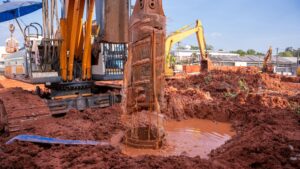When delving into the intricacies of mineral rights in South Dakota, a myriad of factors come into play. These rights are not just legal entities; they represent a complex intersection of geography, law, and economics.
This guide aims to demystify the concept of mineral rights in South Dakota, shedding light on how they function, their impact on landowners, and the major oil and gas fields that mark the state’s landscape.
How do Mineral Rights Work in South Dakota?
In South Dakota, mineral rights refer to the ownership and entitlement to underground resources like minerals, oil, and gas. These rights can be owned separately from the land itself, meaning a person can own the rights to the minerals beneath the surface without owning the surface land. This duality often leads to diverse interactions between mineral rights owners and surface landowners.
Legal Framework and Ownership
The legal framework governing these rights in South Dakota is complex. The South Dakota Supreme Court has played a pivotal role in interpreting laws related to mineral rights, often focusing on aspects like the ‘register of deeds’ and the nuances of ‘mineral interest’ ownership. For instance, the transfer of mineral rights often requires a detailed legal process involving deeds and possibly the circuit court, especially in cases of joint tenants or life estate affidavits.
Surface Rights vs Mineral Rights in South Dakota
Understanding the distinction between surface rights and mineral rights is crucial in South Dakota. Surface rights pertain to the ownership of the land’s surface, while mineral rights involve the underground resources. In many cases, these rights are held by different entities, which can lead to conflicts. For instance, a surface owner might have plans for the land that are disrupted by the mineral rights owner’s exploration activities. Legal provisions and state laws often dictate how these conflicting interests are balanced, with a focus on ensuring fair use and compensation.
What is Included in Mineral Rights in South Dakota?
The term “mineral rights” in South Dakota encompasses a broad array of underground resources. These rights grant the holder the ability to explore, extract, and profit from minerals beneath the land’s surface. In South Dakota, this typically includes:
- Oil and Gas: These are the most commonly sought-after resources under the surface estate. The extraction of oil and gas in South Dakota is governed by stringent regulations and often involves securing an exploration permit.
- Coal and Uranium: Coal mining has a historical significance in the state, while uranium, albeit less common, is also included under mineral rights.
- Other Minerals: This category includes a variety of other valuable substances such as bentonite, gypsum, rock, and shale, essential for different industrial uses.
Owners of mineral rights in South Dakota have the opportunity to lease these rights to third parties, often resulting in substantial income, especially in areas rich in oil and gas.
Surface Rights in South Dakota
In contrast to mineral rights, surface rights in South Dakota pertain to the ownership and use of the land’s surface. Surface owners may use the land for agriculture, construction, or other purposes, but they do not automatically have rights to the minerals beneath the surface. This separation often leads to situations where surface owners and mineral rights owners must coexist, sometimes leading to disputes over land use, especially when exploration and extraction activities commence.
The South Dakota Supreme Court has set precedents in cases where surface and mineral rights conflict, emphasizing the importance of balancing the interests of both parties. Understanding and respecting the rights and obligations of each party are essential in maintaining a harmonious relationship between surface owners and mineral rights owners.
How do I Find Out Who Owns Mineral Rights in South Dakota?
Discovering the ownership of mineral rights in South Dakota involves a multi-step process. This information is vital for individuals interested in purchasing land, engaging in mineral exploration, or simply understanding their property rights.
Steps to Determine Mineral Rights Ownership:
- Consult the County Register of Deeds: Start by visiting the office of the register of deeds in the county where the land is located. They maintain records of land ownership and transactions, including mineral rights.
- Review Property Deeds: Property deeds often contain information about the ownership of mineral rights. Look for any clauses or terms that specify the separation of surface and mineral rights.
- Research Historical Documents: In some cases, mineral rights might have been sold or transferred separately from the land many years ago. This may require a thorough investigation of historical records.
- Seek Legal Assistance: Due to the complexity of property laws in South Dakota, consulting with an attorney specializing in mineral rights can provide clarity and professional guidance.
How to Search for Mineral Rights Records in South Dakota?
Searching for mineral rights records in South Dakota requires a systematic approach, as these records are essential for understanding property rights and potential legal implications.
Steps to Search for Mineral Rights Records:
- Access the State’s Online Resources: Utilize the online databases provided by the South Dakota government, which may offer initial insights into mineral rights ownership.
- Visit the County Register’s Office: Physical records and documents are often stored at the county register’s office. This step is crucial for obtaining official and detailed information.
- Use Professional Land Services: Consider employing the services of a landman or a professional company specializing in tracing mineral rights. They have the expertise and access to comprehensive databases.
- Explore Geological Surveys and Maps: Geological surveys and maps can provide context and additional information about the mineral composition and potential of the land.
How do I Claim Mineral Rights in South Dakota?
Claiming mineral rights in South Dakota is a process governed by state laws and regulations. It often involves proving ownership, navigating legal requirements, and sometimes engaging in the judicial process.
Steps to Claim Mineral Rights:
- Establish Ownership: The first step is to establish your claim to the mineral rights. This involves gathering all relevant documents, such as deeds and historical records, that prove your ownership or inheritance of the rights.
- File a Statement of Claim: In South Dakota, it may be necessary to file a statement of claim with the county register of deeds, particularly if the mineral rights have not been actively used or leased.
- Seek Legal Counsel: Due to the complexities involved in claiming mineral rights, especially in disputed cases, it’s advisable to consult with a lawyer who specializes in this area of law.
- Comply with State Regulations: Ensure compliance with all state regulations, including any necessary permits or registrations related to mineral exploration or extraction.
How Does Mineral Rights Inheritance Work in South Dakota?
Inheriting mineral rights in South Dakota is a process governed by both state law and the specifics of the decedent’s estate plan. When a property owner passes away, their mineral rights, unless otherwise specified, become part of their estate and are subject to inheritance.
Legal Considerations and Process:
- Estate Planning Documents: Wills or trusts often dictate how mineral rights are to be distributed. In the absence of such documents, state succession laws apply.
- Transfer of Ownership: To formalize the inheritance, the heirs must record a transfer document, like a life estate affidavit or a deed, with the county register of deeds.
- Joint Tenancy and Tenancy in Common: If the mineral rights are held in joint tenancy, they automatically transfer to the surviving owner(s). In a tenancy in common, the decedent’s share is distributed according to their will or state law.
- Tax Implications: Heirs should be aware of any tax responsibilities associated with inheriting mineral rights, including potential income from leases or production.
How are Mineral Rights and Leases Taxed in South Dakota?
Mineral rights and leases in South Dakota are subject to specific tax regulations. These include:
- Property Taxes: Mineral rights are considered real property and may be subject to property taxes, even if not actively producing.
- Income Taxes: Revenue generated from mineral rights, such as royalties from oil or gas production, is taxable income.
- Lease Taxes: Taxes may also be levied on lease agreements for mineral exploration and extraction.
How Much are Mineral Rights Worth in South Dakota?
The value of mineral rights in South Dakota varies significantly based on factors like location, type of minerals, and market conditions. This value is a critical consideration for both buyers and sellers.
How Much are Mineral Rights Worth Per Acre in South Dakota?
The average price per acre for mineral rights can range widely. As of the latest data, prices per acre in South Dakota might range from $500 to over $2,500, depending on the aforementioned factors. However, these figures can fluctuate based on market dynamics, such as changes in oil and gas prices.
Leasing Mineral Rights Value
Leasing mineral rights can provide a steady income stream. The value of a lease depends on the potential productivity of the land and the current demand for the specific minerals. Lease agreements typically include a signing bonus, royalty percentages, and other terms that impact overall value.
Non-Producing Mineral Rights Value
Non-producing mineral rights, where no active extraction is occurring, usually have a lower value compared to producing ones. However, their potential future value, if exploration yields profitable resources, can make them an attractive investment.
Producing Mineral Rights Value
Producing mineral rights, where active extraction is occurring, are generally more valuable. The value is often calculated based on the current and projected income from the extracted resources, considering factors like production rates, market prices, and operational costs.
How Do You Buy Mineral Rights in South Dakota?
Acquiring mineral rights in South Dakota involves a strategic approach, considering legal, financial, and geological factors. Prospective buyers need to navigate through various steps to ensure a smooth transaction.
Steps to Buy Mineral Rights
- Research and Identify Potential Lands: Utilize online resources and county records to identify lands with available mineral rights in South Dakota.
- Conduct Due Diligence: Investigate the legal status of the mineral rights, including any existing leases, encumbrances, and the history of mineral extraction.
- Evaluate Geological Potential: Assess the potential for oil, gas, or other minerals on the land. This may involve consulting geological surveys and possibly hiring a geologist.
- Consult with an Attorney: Engage a lawyer experienced in South Dakota mineral laws to review contracts and ensure legal compliance.
- Negotiate Terms and Price: Negotiate the purchase terms, price, and conditions with the seller, keeping in mind the market value and potential yield.
- Complete Legal Transactions: Finalize the transaction with proper legal documentation, ensuring it’s filed with the appropriate county register of deeds office.
How To Sell Your Mineral Rights in South Dakota?
Selling mineral rights in South Dakota can be a lucrative decision but requires careful planning and execution. Here are the steps to sell mineral rights effectively.
Steps to Sell Mineral Rights
- Assess the Value: Determine the value of your mineral rights based on current market conditions, past production, and potential reserves.
- Market Your Rights: Utilize various platforms to market your mineral rights to potential buyers. This can include online listings, industry publications, and hiring a broker.
- Vet Potential Buyers: Evaluate the credibility and financial capacity of interested buyers to ensure a smooth transaction.
- Negotiate the Sale: Engage in negotiations, focusing on getting a fair price and favorable terms.
- Prepare Legal Documents: Have legal documents prepared, preferably by an attorney knowledgeable in South Dakota’s mineral rights laws.
- Close the Sale: Finalize the sale with a legal transfer of the rights, ensuring all documents are properly recorded with the county.
How Do I Transfer Mineral Rights in South Dakota?
Transferring mineral rights in South Dakota involves a series of legal steps to ensure that the rights are correctly passed on to the new owner.
Steps to Transfer Mineral Rights
- Prepare the Deed: Draft a mineral deed or a legal document that clearly states the transfer of mineral rights.
- Verify Ownership: Ensure that the current owner has the legal right to transfer the mineral rights.
- Record the Transfer: File the deed with the county register of deeds where the property is located.
- Notify Interested Parties: Inform any tenants, lessees, or other parties affected by the transfer.
- Consult Legal Advice: It is advisable to seek guidance from an attorney to navigate the transfer process effectively.
FAQs
1. Do Mineral Rights Expire in South Dakota?
In South Dakota, mineral rights do not expire simply due to the passage of time. However, if mineral rights are not used or leased for a certain period, they may be subject to abandonment laws.
2. What Happens to South Dakota Mineral Rights When Someone Dies?
When a mineral rights owner in South Dakota dies, the rights are transferred to their heirs or as dictated by their will. The transfer process involves legal documentation and potentially the probate court.
3. Can You Sell Land and Keep Mineral Rights in South Dakota?
Yes, in South Dakota, it’s possible to sell the surface estate of a property while retaining the mineral rights. This requires clear legal documentation separating the two during the sale process.









Leave a Reply